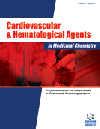- Home
- A-Z Publications
- Cardiovascular & Hematological Agents in Medicinal Chemistry (Formerly Current Medicinal Chemistry - Cardiovascular & Hematological Agents)
- Previous Issues
- Volume 20, Issue 3, 2022
Cardiovascular & Hematological Agents in Medicinal Chemistry (Formerly Current Medicinal Chemistry - Cardiovascular & Hematological Agents) - Volume 20, Issue 3, 2022
Volume 20, Issue 3, 2022
-
-
Anticoagulation in Atrial Fibrillation Associated with Mitral Stenosis
More LessRheumatic valve disease is present in 0.4 % of the word population, mainly in lowincome countries. Rheumatic mitral stenosis affects more women and between 40 to 75 % of patients may have atrial fibrillation (AF), more frequently in upper-middle income countries. This rhythm disturbance is due to increased atrial pressure, chronic inflammation, fibrosis, and left atrial enlargement. There is also an increase in the prevalence Read More
-
-
-
Coagulopathy and Brain Injury Pathogenesis in Post-Covid-19 Syndrome
More LessThe post-COVID neurological syndrome has been coined, which describes the functional and structural sequelae of coronavirus infection disease-19 (COVID-19) in the brain. Mild/severe manifestations of the post-COVID neurological syndrome have been identified in approximately 33.00% of COVID-19 survivors. The presence of neurological complications after COVID allowed neuropathologists to investigate in-depth the role Read More
-
-
-
The Effect of Aspirin on the Prevention of Pro-thrombotic States in Hospitalized COVID-19 Patients: Systematic Review
More LessIntroduction: Thromboembolic events are one of the important complications in COVID-19 patients, especially in severe cases. Aspirin affects platelet function by irreversibly inhibiting cyclooxygenase activity, reducing the risk of thrombosis. The current systematic review aimed to evaluate aspirin's effectiveness in preventing pro-thrombotic states in COVID-19 hospitalized patients. Methods: The systematic search was done i Read More
-
-
-
Effect of Pulicaria mauritanica on Glucose Metabolism and Glycogen Content in Streptozotocin-Induced Diabetic Rats
More LessAuthors: Amine Azzane, Ayoub Amssayef, Ahmed El-Haidani and Mohamed EddouksAims: The study aimed to assess the antihyperglycemic activity of Pulicaria mauritanica. Background: Pulicaria mauritanica is a medicinal and aromatic plant used for the treatment of many diseases such as inflammation, diabetes, and intestinal disorders. Objective: The main goals of this present paper were to confirm the antihyperglycemic capacity of aqueous extract from Pulicaria mauritanica in normoglycemic and dia Read More
-
-
-
Artocarpus Altilis (Breadfruit) could Reverse Myocardial Infarction Through the Normalization of the Oxygen Haemoglobin Dissociation Curve
More LessObjective: The study was performed to assess if hematological mechanisms such as blood flow modulation, P50 and Oxygen haemoglobin dissociation are involved in Artocarpus altilis leaf extract amelioration of Isoproterenol-Induced Myocardial Damage in rats. Methods: Twenty (20) adult male Sprague-Dawley rats were randomly divided into 5 groups. Group 1 served as the control, group 3 and 5 received 50 and 10 Read More
-
-
-
Effect of Calamintha officinalis on Vascular Contractility and Angiotensinconverting Enzyme-2
More LessAuthors: Amine Azzane, Bouchra Azzaoui, Mourad Akdad, Ismail Bouadid and Mohamed EddouksAims: The study aimed to assess the antihypertensive activity of Calamintha officinalis. Background: Calamintha officinalis (CO) is a medicinal and aromatic herb as well as an antihypertensive plant that is widely used for its medicinal properties in several regions. Objective: This study aimed to evaluate the effect of the aqueous extract of Calamintha officinalis (AECO) on vasorelaxant activity and arterial blood pressure under no Read More
-
-
-
Ethnobotanical Survey of Medicinal Plants used to Treat Cardiovascular Disorders in Ghasemloo Valley of Urmia City
More LessAuthors: Gholam Basati, Saber Abbaszadeh, Afshin Hasanvand and Parastoo BaharvandAims: Many pharmaceutical plants belonging to this region are used as the traditional drug by traditional physicians of the Urmia city in order to treat signs of disorders and cardiovascular system diseases. Background: The Ghasemloo valley located in Urmia city is one of the typical areas in northwestern Iran and includes many pharmaceutical and plant species. Objective: Many pharmaceutical plants belonging to this region Read More
-
Volumes & issues
-
Volume 23 (2025)
-
Volume 22 (2024)
-
Volume 21 (2023)
-
Volume 20 (2022)
-
Volume 19 (2021)
-
Volume 18 (2020)
-
Volume 2 (2020)
-
Volume 17 (2019)
-
Volume 16 (2018)
-
Volume 15 (2017)
-
Volume 14 (2016)
-
Volume 13 (2015)
-
Volume 12 (2014)
-
Volume 11 (2013)
-
Volume 10 (2012)
-
Volume 9 (2011)
-
Volume 8 (2010)
-
Volume 7 (2009)
-
Volume 6 (2008)
-
Volume 5 (2007)
-
Volume 4 (2006)
Most Read This Month
Article
content/journals/chamc
Journal
10
5
false
en


